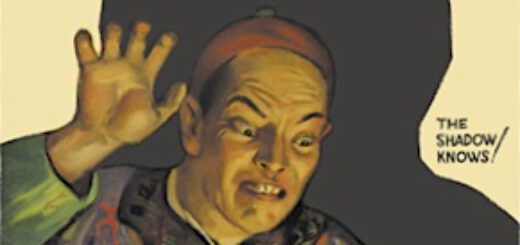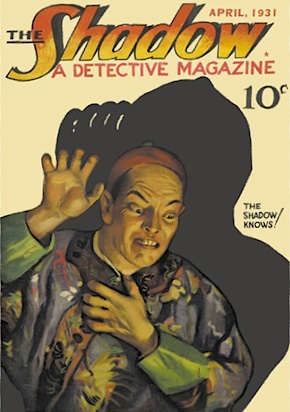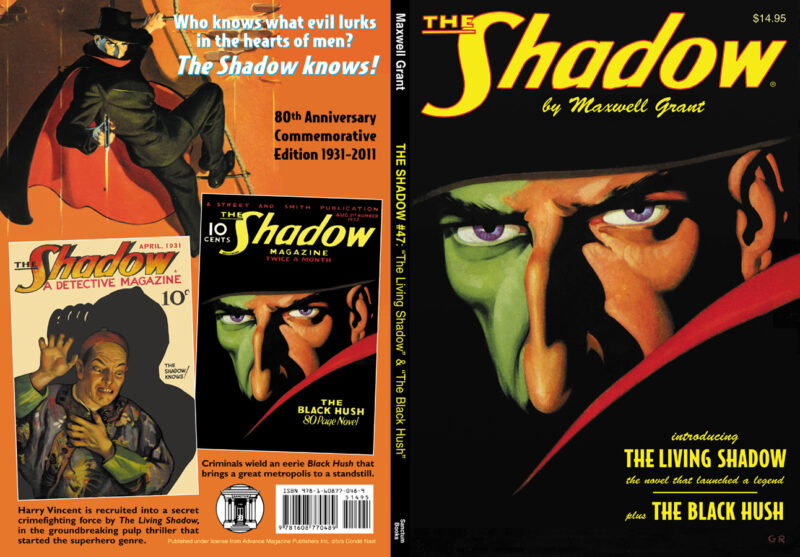It was 75 Years Ago The Shadow hit the Comic Racks
 Seventy-five years ago, The Shadow and Doc Savage made their four-color debut on January 21st, 1940 in SHADOW COMICS #1, which also featured the first comic book appearances of Nick Carter, Bill Barnes, Frank Merriwell, Iron Munro and a variety of other popular Street & Smith pulp characters.
Seventy-five years ago, The Shadow and Doc Savage made their four-color debut on January 21st, 1940 in SHADOW COMICS #1, which also featured the first comic book appearances of Nick Carter, Bill Barnes, Frank Merriwell, Iron Munro and a variety of other popular Street & Smith pulp characters.
With the possible exception of WALT DISNEY’S COMICS & STORIES, it is unlikely that any other comic magazine ever debuted with as many pre-proven famous characters. The Shadow had already starred in nearly 200 pulp novels and several films, while his weekly radio show had the highest audience ratings in daytime radio. Iron Munro was based on John W. Campbell’s novel THE MIGHTIEST MACHINE, one of the inspirations for Jerry Siegel’s SUPERMAN, and featured the exploits of a human born and raised under Jupiter’s high gravity who arrived on Earth to discover that his denser molecular structure gave him invulnerability, super strength and the ability to leap huge distances. Doc Savage’s monthly pulp magazine was reputed to have the highest per-issue circulation of any hero pulp, while Nick Carter and Frank Merriwell had been American icons going back to the Dime Novel era of the previous century. SHADOW #1 also featured adventures of CRIME BUSTERS’ distaff detective Carrie Cashin, the Air Trails Boys and famous Street & Smith dime novel properties including Diamond Dick and Horatio Alger’s Bob Burton and Mark the Match Boy.
In creating the earliest comic book superheroes, Superman’s Jerry Siegel and Joe Shuster, Batman’s Bob Kane and Bill Finger, Joe Simon, Jack Kirby, Stan Lee and Will Eisner took inspiration from the supermen of their own youth: legendary pulp heroes like The Shadow, Doc Savage, Zorro and The Whisperer. Bill Finger even acknowledged that his “first script was a take-off on a Shadow story” and that “I patterned my style of writing after The Shadow.” Bob Kane agreed, saying: “I suppose both The Shadow’s cloaked costume and double-identity role, as well as the extraordinary acrobatics of Douglas Fairbanks, Sr., did more to my subconscious to create the character and personality of Batman than any other factors.”
Though Street & Smith had pioneered the hero magazine genre with its SHADOW and DOC SAVAGE pulps, the nation’s largest publisher of pulp fiction magazines was slow to move into the rapidly expanding comics market, initially rejecting comics because it avoided publishing material that couldn’t be printed on its own Manhattan in-house presses.
In 1937, Shadow wordsmith Walter B. Gibson had attempted to interest Street & Smith in a Shadow comic book after noticing that the new comic strip reprint magazines were successfully competing for newsstand space with THE SHADOW MAGAZINE. When promotions manager William de Grouchy pointed out that the most popular newspaper strips had already been bought up by rival publishers, Gibson countered, “Why not get up some and sell them to syndicates and get the rights to use them in comic books? And we should begin with The Shadow.” Unfortunately, the executive initially rejected Gibson’s suggestion which could have resulted in The Shadow and other Street & Smith characters debuting in comics ahead of Superman and Batman (whose first appearance in DETECTIVE COMICS #27 was an unauthorized adaptation of “Partners of Peril,” a 1936 Shadow pulp novel).
Despite this delay, SHADOW COMICS was still one of the first comic books to bear the name of its lead character, closely following on the heels of AMAZING MAN COMICS, FLASH COMICS and BLUE BEETLE COMICS, and preceded the first issue of BATMAN by several months. However, despite its title, SHADOW COMICS was actually an anthology comic featuring a wide range of characters, and had originally been planned as ASTOUNDING COMICS and advertised as STREET & SMITH COMICS, before being retitled SHADOW COMICS in the eleventh hour to tie in with the release of Columbia’s THE SHADOW movie serial.
SHADOW COMICS sold an average of 425,000 copies per issue in 1941 and continued for 101 issues, with its final issue appearing in 1949. The Doc Savage and Bill Barnes four-color features introduced in its first issue were soon promoted to headline their own comic anthologies, with DOC SAVAGE #1 debuting in April 1940 and BILL BARNES later that same year. Supersnipe (“the boy with the most comic books in America”) also debuted in SHADOW COMICS before moving on to its own successful comic book series.
Fifteen years after the Golden Age series ended, THE SHADOW was revived first by Archie’s Radio Comics imprint, and was later published by DC Comics, Dark Horse and Dynamite, and also appeared in a Marvel Comics graphic novel by Denny O’Neil and Michael Kaluta. The original Shadow and Doc Savage pulp novels are also currently being reissued by Sanctum Books trade paperback imprint.






 Adrienne Roy, whose colorful storytelling was a fixture throughout two decades of Batman and other best-selling DC comic books, lost a year-long battle with cancer on December 14th.
Adrienne Roy, whose colorful storytelling was a fixture throughout two decades of Batman and other best-selling DC comic books, lost a year-long battle with cancer on December 14th.








